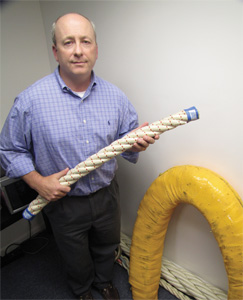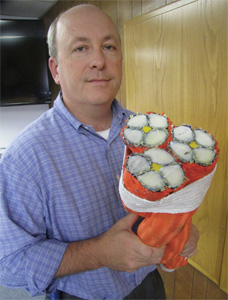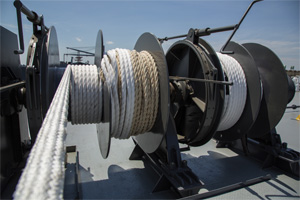An oil company thought it was ready to install a structure on the seabed in the Gulf of Mexico. A problem arises due to hydrographic conditions and the great depth. Stronger permanent platform mooring lines or lifting and lowering lines are required.
That’s when a phone rings in Chester, Pa.
It’s the oil driller calling Whitehill Manufacturing, a specialty producer of synthetic cordage. The customer explains what’s needed in the Gulf and asks, “Do you think you can make something like that that will work?”
Whitehill is best known in the industry for combining traditional laying techniques with the latest highly engineered materials. At its 7-acre complex near the Delaware River, Whitehill creates made-to-order maritime ropes including lines for oil rigs and underwater installation, anchor-recovery lines, mooring lines for large ships, lightering grommets for tankers and emergency towlines.
“We’re cordage engineers who happen to have a manufacturing capability,” said Robert Guldi, Whitehill’s product engineer. “We’re almost artisan.”
Much of Whitehill’s output contains aramid, of which one brand name is Kevlar. Other materials in the company’s products are high modulus polyethylene (HMPE), nylon and polyester. While other makers of synthetic lines use double-braiding or plaiting patterns to lay the strands, Whitehill’s lines are cable-laid or wire-laid — just like the traditional steel lines. Indeed, the company’s winding operation still uses a set of planetary cabling machines that were originally built to make steel wire.
 |
|
Whitehill’s Robert Guldi displays a segment of a 2 1/4-inch HMPE Navy mooring line. The yellow object is part of an eye for a permanent platform mooring, covered with a polyurethane coating. |
|
Dom Yanchunas |
That means Whitehill’s synthetic products are compatible with existing wire that is still in use for heavy-marine applications. The patterns are synchronized and are torque-neutral. The new synthetic product can connect to a steel line using a Mandal fairlead shackle. Often the same winch can wind up the steel and synthetic.
Exploration in deeper waters has increased the demand for this. When pulling up anchors, adding a long segment of the lighter synthetic line allows the operator to hire a less expensive anchor-handling tug to do the job.
“Our lines work well with steel lines. We can just attach our line to steel lines, and it gives them the ability to work deeper,” Guldi said. “So by augmenting it or replacing it with HMPE, you can use a much smaller vessel to handle it.”
Whitehill makes ship mooring lines for customers including the U.S. Navy and USS Chartering and recently provided the mooring lines for SeaRiver Maritime’s new tanker Liberty Bay. For the 820-foot Liberty Bay, Whitehill laid three strands of HMPE, each with a jacket consisting of polyester, and added an HMPE over-jacket to areas of the line that are most likely to encounter friction. An additional over-jacket is helpful for any line that abrades against bollards, winch corners or the ship’s bow. The inner jackets protect the fibers that support the load.
“The jacket has alternating Kevlar and polyester, so only half of the surface area touches the surface, and that cuts down on abrasion. If there’s any damage, the Kevlar tends to arrest the damage in that area,” Guldi said. “We use these fibers that are inexpensive to protect the expensive fibers.”
The Whitehill technique results in a rope that is heavier and more rigid than other companies’ HMPE configurations, which Guldi argues are more susceptible to twisting. He demonstrates by using a segment of synthetic line that is differently braided, pointing out that certain strands can bend outward.
“When you twist it, you see that some of the lines are loose and are not participating. They are slack and are not supporting the load, and it makes the line shorter too,” Guldi said. “It’s what you call overloading the line, and it gives it a much shorter life.”
By contrast, the Whitehill fibers tend to stay in position, in concert with one another.
“Because it’s wire-laid, there is not the twisting that’s going on. When they move, they move together,” Guldi said. “There has to be the same level of synchronicity.”
One project that proved the durability was an order from Chevron, which needed better lightering grommets to connect crude carriers when transferring loads off the California coast. Whitehill came up with a 2.5-inch-diameter, four-stranded nylon line, with a polyester jacket. It lasts five years, compared to the three- to six-month service life for the grommets Chevron used before.
“They had another product and it wasn’t lasting very long, and they were afraid of having a catastrophic failure. You have the swells in the Pacific, and you have a lot of dynamic movement” between the two tankers, Guldi said. “So we partnered with them. We came up with a design and a test plan. It generated a very long fatigue life.”
 |
|
Guldi shows a cross-section of Whitehill’s HMPE anchor-recovery line with an orange polyester jacket. The company is often called upon to fabricate custom heavy cordage not only for ships and marine towing but also for deepwater applications. |
|
Dom Yanchunas |
Whitehill Manufacturing was founded in 1978 by A. Simeon Whitehill, who is still president. At a previous company, Simeon Whitehill specialized in manufacturing rope out of fiberglass. When the E.I. du Pont company introduced Kevlar, he wanted to make Kevlar lines but his employer wasn’t interested. So he started his own company, which flourished.
For about 20 years, Whitehill has been the maker of the world’s largest continuously laid man-made structure — the 17,500-foot-long aramid outdoor reel cables that stretch across two mountaintops at the White Sands Missile Range.
Diameters of the company’s ship mooring lines range from 1 5/8 inches to 2 inches. Emergency towlines are about 3 3/4 inches. Offshore anchor lines are 5 to 6 inches, and lifting and lowering lines are 6 to 10 inches. Permanent platform moorings are 10 or 11 inches in diameter. The company also makes ship-assist lines, pendants and towing hawsers.
Whitehill is getting involved in developing underwater lines for the tidal and wind energy industries. Perhaps its most unique project was the manufacture of an arresting line installed in the St. Lawrence River at Beauharnois, Quebec, that is designed to slow an out-of-control ship to protect a hydroelectric plant there.
At its facility near the Commodore Barry Bridge, the company has three test beds to assess breaking strength and abrasion resistance.
“We have our own test facility and we do that for free if you buy our line,” Guldi said. “USS Chartering and SeaRiver send up their lines to inspect, and that saves them from buying new line. … We can tell them what percentage of the break strength is remaining. We repair any damage, put a new eye on them and clean up the outside jacket, and it can go back in service.”
Whitehill’s products are not necessarily the best choice for every maritime operator. Lighter products are sometimes preferable. Whether other braiding methods provide a longer fatigue life is hotly debated. Deck crews may complain about the heavier mooring lines.
“We have more processes and materials in the line,” Guldi said. “It makes it stiffer and harder to handle for them. We understand that it’s a hurdle.”
Many Whitehill products are designed so there will be no recoil if they break. The company believes it is the first to paint a red installation-tracking line along the length of underwater mooring lines so ROV operators can see if the line is twisting. These improvements augment other attributes for which Whitehill is known, particularly the alternating aramid and polyester jackets.
“We go through the extra steps to protect that investment,” Guldi said. “In our experience and our customers’ experience, this type of construction lends itself to longer fatigue life.”

